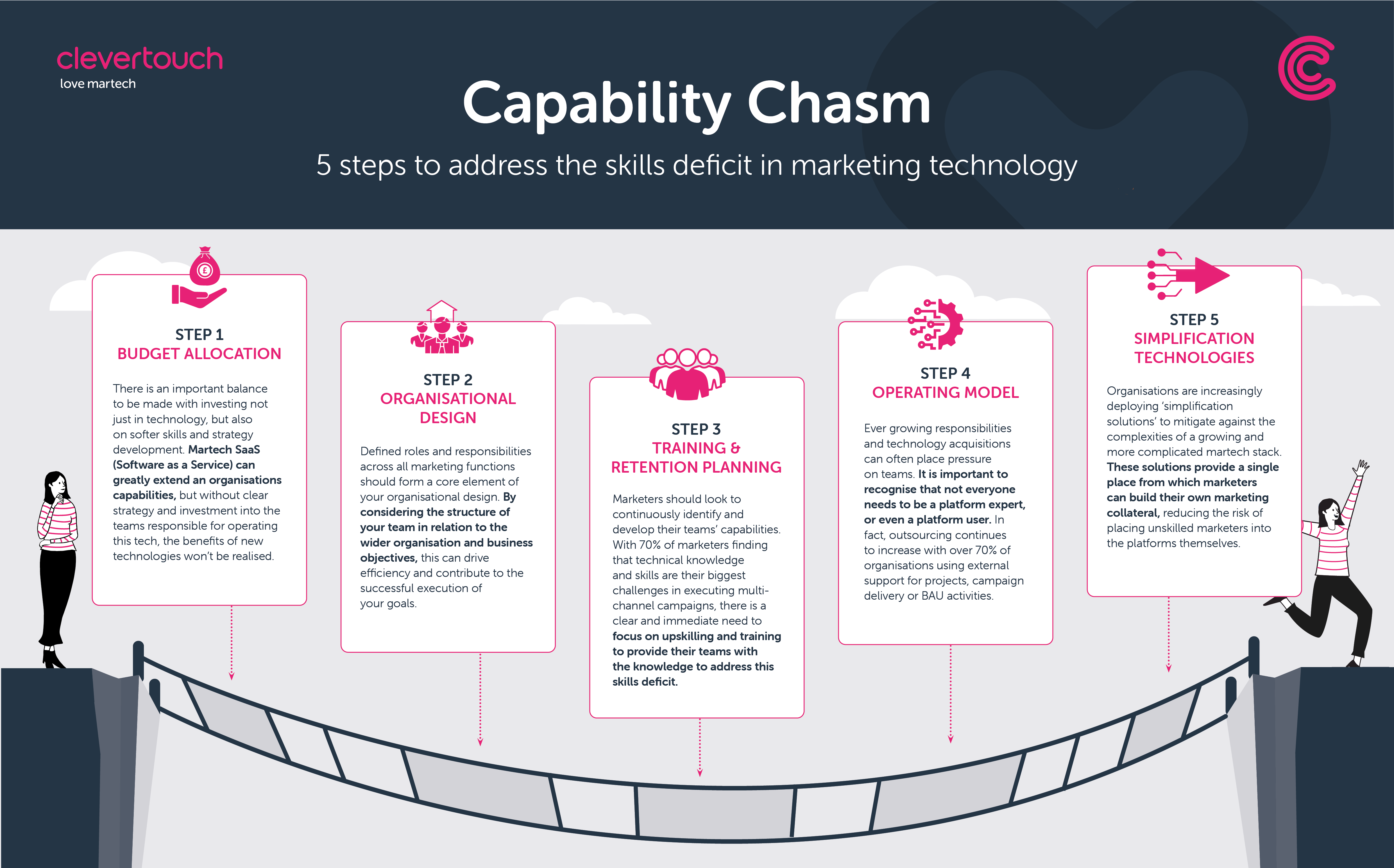The 5 Steps to addressing the digital skills deficit Part 2: Organisational Design
Check out our infographic on the 5 steps to address the skills deficit in marketing technology here for more information.
What is organisational design and why does it matter so much?
Your organisational design is the alignment and structure of your team in relation to your wider organisation based on business objectives and desired outcomes. Ultimately the goal of good organisational design is to improve the efficiency and effectiveness of your business.
Driven by a passion over reliability, and meaning over salary, the digital natives that make up more and more of our workforce have a higher expectation of their roles, and in turn their employers. This expectation and desire for progression, along with a high demand for skills that are in shortage, is fuelling a war for marketing technology talent. According to our recent survey, 72% of senior marketers have struggled to hire Marketing Automation and Cloud specialists, so if you find yourself lucky enough to have one in your team, it’s never been so important that you hold onto them.
Ensuring your organisational design supports and enables personal growth, rather than restricts and limits, has never been so crucial if you want to hold on to your marketing technology talent. If your employees feel undervalued, restricted by capability, or do not feel they are making a difference, they will go. Job security, a good salary, and flexi-time are no longer enough.
Aside from the difficulties hiring to meet business needs, you will also find the resource efficiencies and cost effectiveness of a good organisational design will significantly improve business operation. It goes without saying that people doing jobs they enjoy, with the right training and enablement to allow them to do it efficiently, will improve the quality and speed at which they work.
Steps to organisational design and marketing technology
1. Structure follows strategy
The backbone of good organisational design is understanding the strategy of your Marketing function and the impact you want to see as a result. Having a clear view of Marketing’s goals and objectives will inform the structure of your team. Developing your team structure before fully understanding what it is you want to achieve will lead to more changes and uncertainty down the line.
With the increased adoption of marketing technology, more and more businesses are seeing the value of a centralised approach where one team is responsible for marketing campaign and program delivery through martech. This provides an additional level of governance and quality control whilst supporting efficiencies within the team.
Opposingly, a regional or divisional approach – where there are martech specialists operating in each region or team - can support with localisation efficiencies and empower regional teams. This does however add risk when recruiting and retaining skilled members of the regional teams.
2. Roles and Responsibilities
Ensuring your teams have clear roles and responsibilities around marketing technology not only empowers people to own their roles but reduces ambiguity which can cause confusion and unnecessary time wasted.
Understanding your team members aspirations for their roles will ensure you have the right people doing the right job. Forcing people to adopt new technologies or ways of working if they are not bought in will only create detractors in the team which can lead to negativity amongst team members.
In doing this you will by default empower talent within the team by giving them the time and capacity to come up with new ideas and new thinking, ensuring that they are not in roles where they are solely in a wheel of delivery.
Once responsibilities are defined, adopting clear communication channels, SLA’s, workflows and encouraging an appreciation for other function’s responsibilities will support with cohesion and working relationships between team members.

(Example organisational design strategy and defined roles and responsibilities)
3. Training and Enablement
Once you have the structure of your teams aligned to your business objectives and your team’s roles and responsibilities defined, you can train and upskill your team to meet the needs of their roles. Training in isolation is not a solution, however ensuring people have the right tools and training to do their jobs creates job satisfaction and supports retention.
Training and enablement need to be sustained; enablement tools such as playbooks and documentation, online learning and support mechanisms will futureproof your processes. New starters will be upskilled faster and will require less resource from established team members allowing them to get on with their day jobs.
One of our clients, a leading IT Distributor, saw an opportunity to upskill disparate teams by creating self-serve online training modules designed to educate teams at their own pace. The modules we designed were bespoke to their needs and largely sat outside of the marketing technology. Providing this level of training on the ‘why’ not just the ‘how’ supported with the context required once training in the platform started.
For a successful marketing technology strategy, you must consider your organisational design. Our 3 steps to organisational design - realise that structure follows strategy, understand the roles and responsibilities of your marketing team, and ensure long-term success by investing in training and enablement.
Why not find out more about how we can optimise your marketing technology investment through organisational design.



_nvbug.png?w=470&h=&q=100&&fm=png&fit=crop&crop=edges,faces)